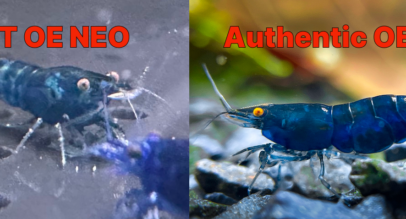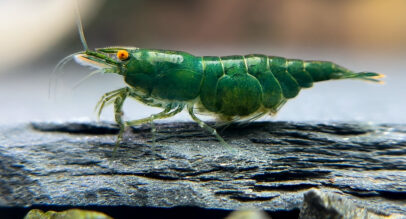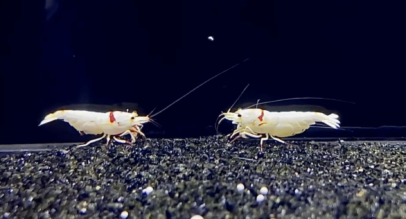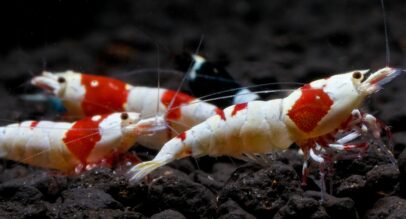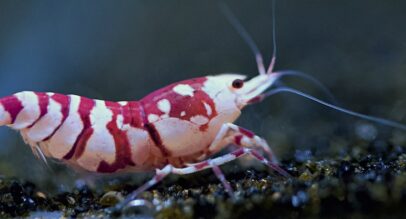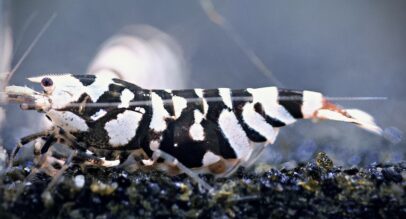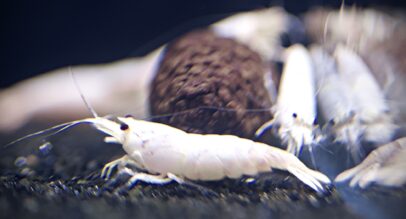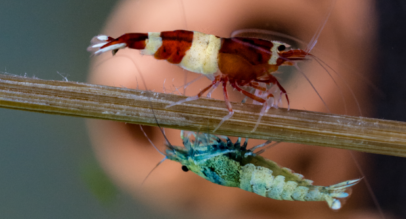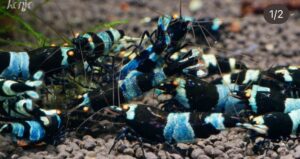 Caridina shrimp have become increasingly popular in the aquarium hobby due to their vibrant colors, intricate patterns, and fascinating behaviors. Among the many captivating varieties, the Orange Eye Blue Panda stands out as a highly sought-after species. These small freshwater shrimp are native to rivers and streams in Asia and have specific requirements for optimal health and breeding success.
Caridina shrimp have become increasingly popular in the aquarium hobby due to their vibrant colors, intricate patterns, and fascinating behaviors. Among the many captivating varieties, the Orange Eye Blue Panda stands out as a highly sought-after species. These small freshwater shrimp are native to rivers and streams in Asia and have specific requirements for optimal health and breeding success.
One of the most critical factors in keeping any Caridina shrimp species is maintaining the proper water parameters, with temperature being a key variable. Caridina are considered cold-water shrimp and have a fairly narrow range of ideal temperatures in which they thrive. Too high or too low of a temperature can lead to stress, breeding issues, molting problems, and even death.
In this article, we will take an in-depth look at the ideal temperature requirements for the Orange Eye Blue Panda Caridina shrimp. By understanding their natural habitat conditions and replicating them in the home aquarium, shrimp keepers can provide the optimal environment for their colonies to flourish. We’ll discuss the recommended temperature range, factors that influence water temperature, and tips for consistent temperature maintenance. Armed with this knowledge, both novice and experienced shrimp enthusiasts can confidently care for these
Ideal Temperature Range for Caridina Shrimp
Caridina shrimp, including the Orange Eye Blue Panda variety, have evolved to thrive within a specific temperature range. While they can tolerate a wider span of temperatures, maintaining the ideal range is crucial for their long-term health, growth, and breeding success.
General optimal temperature range
The sweet spot for keeping Caridina shrimp falls between 64-72°F (18-22°C). Within this range, these shrimp can carry out their natural behaviors, maintain a healthy metabolism, and resist common diseases. Stability is key – aim to keep the temperature consistent without any sudden fluctuations.
Tolerable range
Caridina shrimp can survive in temperatures as low as 60°F (15.5°C) and as high as 82°F (28°C). However, keeping them at these extremes for extended periods can lead to stress, weakened immune systems, and difficulty molting. If your tank temperature occasionally dips or rises beyond the ideal range, take swift action to gradually bring it back to the optimal level.
Ideal breeding range
Many experienced breeders have found that maintaining temperatures at the lower end of the optimal range, around 70-72°F (21-22°C), can promote better breeding outcomes. Cooler water can trigger the natural breeding instincts of Caridina shrimp and encourage females to produce more eggs. Keep in mind that other factors, such as water quality and diet, also play significant roles in successful breeding.
By understanding and adhering to these temperature guidelines, you can create a comfortable and nurturing environment for your Orange Eye Blue Panda Caridina shrimp to thrive. In the following section, we’ll explore the various factors that can influence water temperature in your shrimp tank and how to manage them effectively.
Temperature reduction to trigger breeding
Adding cold water to a Caridina shrimp tank can have intriguing effects on molting and breeding behaviors. This process aims to mimic the natural temperature fluctuations these shrimp would experience in their native habitats, which can signal the onset of the breeding season.
Temperature change and molting
A sudden drop in temperature, typically a few degrees, can trigger molting in Caridina shrimp. When the water cools down, it sends a signal to the shrimp that environmental conditions are changing, similar to the seasonal shifts they would encounter in the wild. This temperature cue prompts the shrimp to shed their exoskeletons, enabling growth and potentially preparing them for breeding.
However, it’s crucial to approach this technique with caution. Drastic or frequent temperature changes can cause stress to your shrimp, weakening their immune systems and making them more susceptible to diseases. If you decide to attempt a temperature drop to encourage breeding, do so gradually and monitor your shrimp closely for any signs of distress.
Ideal temperature drop for breeding
Aim for a gradual temperature reduction of 2-3°F (1-1.5°C) over the course of a few days. For example, if your tank is typically maintained at 72°F (22°C), slowly lower the temperature to around 69-70°F (20.5-21°C). This subtle change can be enough to stimulate breeding behavior without causing undue stress to your shrimp.
Maintain the lower temperature for about a week or two, giving your shrimp time to adjust and potentially mate. After this period, gradually raise the temperature back to the normal range. Keep in mind that other breeding triggers, such as water quality, diet, and the presence of mature shrimp, must also be optimized for successful reproduction.
While temperature reduction can be an effective tool in encouraging breeding, it should be used sparingly and with great care. Prioritize maintaining stable, ideal temperatures for the overall health and well-being of your Orange Eye Blue Panda Caridina shrimp, and only attempt breeding triggers when your colony is thriving and ready to reproduce.
Molting and breeding connection
The process of molting and breeding in Caridina shrimp are closely intertwined. Before shrimp can mate, they must first shed their exoskeleton in a process called molting. This allows them to grow larger and develop sexual maturity. Immediately after molting, female shrimp release pheromones into the water, which act as chemical signals to attract male shrimp for mating.
A successful molt is therefore a prerequisite for breeding activity. If a female shrimp fails to molt properly or experiences difficulty during the molting process, she may not be able to mate or produce healthy offspring. By triggering molting through a controlled temperature drop, breeders can potentially increase the chances of successful mating and fertilization.
How it works: To attempt a temperature reduction for breeding, follow these steps:
Water change preparation
First, prepare the water for a partial water change. This water should match the existing tank water in terms of pH, hardness, and mineral content to avoid any shock to the shrimp. You can use a remineralizer or blended RO water to achieve the desired parameters.
The crucial difference is that the new water should be slightly cooler than the current tank temperature. Aim for a temperature difference of around 2-3°F (1-1.5°C). For example, if your tank is at 72°F (22°C), prepare the water at approximately 69-70°F (20.5-21°C).
Gradual water change
Slowly add the cooler water to the shrimp tank over the course of a few hours. You can use a drip acclimation method or a slow siphon to minimize any sudden temperature changes. The goal is to lower the overall tank temperature gradually, mimicking a natural seasonal transition.
Monitor and maintain
Keep a close eye on your shrimp during and after the water change. Watch for any signs of stress, such as erratic swimming or lethargy. If you notice any concerning behavior, stop the water change and allow the temperature to stabilize.
Maintain the lower temperature for about a week to two weeks. This gives your shrimp time to adjust, molt, and potentially mate. After this period, you can gradually raise the temperature back to the normal range through small water changes with slightly warmer water.
Throughout the process, ensure that other water parameters remain stable and optimal. Continue to provide a balanced diet, regular maintenance, and a clean environment for your shrimp to thrive.
Remember, while temperature reduction can encourage breeding in Caridina shrimp, it is not a guarantee. Successful breeding depends on a combination of factors, including water quality, diet, and the overall health of your colony. Use this technique sparingly and always prioritize the well-being of your shrimp above all else.
Temperature differential
The key to successfully triggering molting and breeding through temperature reduction lies in the temperature difference between the new water and the existing tank water. A difference of 2-3°C (approximately 3.6-5.4°F) is typically recommended. This means if your tank is currently at 22°C (71.6°F), you would prepare water that is around 19-20°C (66.2-68°F).
This temperature differential is sufficient to simulate a natural seasonal change without being too extreme. A larger difference could shock your shrimp, causing undue stress and potentially harming their health. Always err on the side of caution and make gradual changes to avoid any adverse effects on your Orange Eye Blue Panda Caridina colony.
Gradual introduction
Once you have prepared the cooler water, it’s crucial to introduce it gradually to the shrimp tank. Adding the entire volume of new water at once can cause a sudden temperature drop, which can be detrimental to your shrimp. Instead, slowly add the cooler water over the course of 30 minutes to an hour.
One method is to use a drip acclimation system, where the new water is slowly dripped into the tank via airline tubing and a control valve. Another option is to use a small cup or container to manually add small amounts of the new water to the tank at regular intervals. This gradual introduction allows your shrimp to acclimate to the changing temperature without experiencing any sudden shocks.
Monitoring and adjusting
Throughout the process of introducing cooler water, closely monitor your shrimp for any signs of distress, such as lethargy, erratic swimming, or loss of appetite. If you notice any concerning behaviors, stop adding the new water and allow the tank temperature to stabilize.
After the water change is complete, continue to monitor the temperature over the next few days. Make small adjustments as necessary to maintain the target temperature range of 19-20°C (66.2-68°F) for the duration of the breeding attempt. This typically lasts for about a week to two weeks.
Reverting to normal conditions
Once the breeding period is complete, you can gradually raise the temperature back to the normal range of 21-22°C (69.8-71.6°F). Do this through small, incremental water changes with slightly warmer water over a few days. This allows your shrimp to readjust to their regular tank conditions without any sudden changes.
While temperature reduction can be an effective tool in encouraging molting and breeding in Orange Eye Blue Panda Caridina shrimp, it should be used sparingly and with great care. Always prioritize the health and well-being of your shrimp colony, and only attempt this technique when your shrimp are thriving and showing signs of readiness to breed.
Volume considerations
When performing a temperature reduction through a water change, it’s essential to consider the volume of cooler water being added. A general guideline is to aim for a 10-20% water change. This means if you have a 20-gallon (75.7-liter) shrimp tank, you would replace 2-4 gallons (7.6-15.1 liters) of tank water with the cooler water.
This percentage strikes a balance between creating a noticeable temperature drop and maintaining overall tank stability. A larger water change could alter the tank’s parameters too drastically, potentially stressing your Orange Eye Blue Panda Caridina shrimp. A smaller change may not have the desired impact on triggering molting and breeding behavior.
Monitoring the drop
As you gradually add the cooler water to your shrimp tank, the overall tank temperature will slowly decrease. Keep a close eye on the temperature using a reliable thermometer to ensure a controlled and steady drop.
The target temperature drop for the entire tank is usually 1-2°C (approximately 1.8-3.6°F). For example, if your tank starts at 22°C (71.6°F), you would aim for a temporary drop to around 20-21°C (68-69.8°F). This temporary decrease mimics the natural seasonal changes that Caridina shrimp experience in their native habitats, which can trigger molting and breeding.
It’s crucial to monitor the temperature closely throughout the process and make adjustments as necessary. If the temperature drops too quickly or falls below the target range, you may need to slow down the addition of cooler water or even stop the water change altogether.
Maintaining the lower temperature
Once you’ve reached the target temperature drop, maintain the lower temperature for about a week to two weeks. This gives your shrimp time to adjust, molt, and potentially mate in response to the simulated seasonal change.
During this period, continue to monitor your shrimp closely for any signs of stress or unusual behavior. Ensure that all other water parameters, such as pH, hardness, and mineral content, remain stable and optimal. Provide a varied and nutritious diet to support your shrimp’s health and breeding success.
Temperature reduction through controlled water changes can be an effective technique to encourage molting and breeding in Orange Eye Blue Panda Caridina shrimp. By gradually lowering the tank temperature by 1-2°C (1.8-3.6°F) through a 10-20% water change with cooler water, you can simulate natural seasonal changes and potentially trigger breeding behavior.
However, this technique should be used cautiously and sparingly, always prioritizing the health and well-being of your shrimp above all else. Monitor your shrimp closely, maintain stable water parameters, and provide optimal care to support their growth and reproduction.
By understanding the ideal temperature requirements and carefully implementing temperature reduction techniques when appropriate, you can create a thriving environment for your Orange Eye Blue Panda Caridina shrimp to flourish and breed successfully in your home aquarium.
Observation period
After completing the gradual water change with cooler water, it’s crucial to closely observe your Orange Eye Blue Panda Caridina shrimp for any signs of stress or increased activity. In the following 24-48 hours, pay particular attention to your shrimp’s behavior and watch for indications of molting or breeding.
Signs of molting may include shrimp hiding more than usual, a visible line forming between the carapace (upper shell) and the abdomen (tail section), or the appearance of a thin, white “skin” on the shrimp’s body. Breeding behavior can be identified by males actively chasing and attempting to mate with females, as well as the presence of berried (egg-carrying) females.
Natural temperature recovery
Once the observation period is complete, most aquarists allow the tank temperature to naturally rise back to its original level over the course of a day or two. This gradual warming mimics the natural temperature fluctuations that occur in the shrimp’s wild habitats after a cool spell.
Avoid using heaters or other devices to rapidly warm the water, as sudden temperature changes can be stressful for your shrimp. Instead, let the room temperature and natural evaporation slowly bring the water back to its normal range.
Frequency and timing
The temperature reduction technique for encouraging molting and breeding in Caridina shrimp should not be used too frequently. Typically, it’s recommended to attempt this no more than once every few months to avoid putting undue stress on your shrimp colony.
Some experienced breeders prefer to time these temperature drops with natural seasonal changes, such as the transition from summer to fall or winter to spring. Others may choose to implement this technique when they notice a decrease in breeding activity within their colony, using it as a way to stimulate reproduction.
Ultimately, the decision to attempt a temperature reduction should be based on a thorough understanding of your specific shrimp colony’s health, behavior, and breeding history. Always prioritize the well-being of your Orange Eye Blue Panda Caridina shrimp and make adjustments to your husbandry practices accordingly.
By carefully monitoring your shrimp during and after the temperature reduction process, allowing for a natural temperature recovery, and using this technique judiciously, you can potentially encourage successful molting and breeding while maintaining a healthy, thriving shrimp colony.
Precautions
When attempting a temperature reduction to trigger molting and breeding in your Orange Eye Blue Panda Caridina shrimp, it’s essential to keep a few precautions in mind. First and foremost, the temperature difference between the tank water and the cooler water added during the water change should not be too extreme. A difference of no more than 2-3°C (3.6-5.4°F) is recommended to avoid shocking your shrimp.
In addition to the temperature, it’s crucial to ensure that the new water closely matches the existing tank water in terms of general hardness (GH), carbonate hardness (KH), and total dissolved solids (TDS). Significant differences in these parameters can cause osmotic shock, which occurs when the shrimp are suddenly exposed to water with a drastically different mineral content. This can lead to stress, molting difficulties, and even death.
Another important precaution is to avoid overusing the temperature reduction technique. Frequently exposing your shrimp to temperature fluctuations can cause chronic stress, weakening their immune systems and making them more susceptible to disease. Limit the use of this method to no more than once every few months, and always base your decision on the overall health and condition of your shrimp colony.
Other factors
While temperature reduction can be an effective way to encourage molting and breeding in Orange Eye Blue Panda Caridina shrimp, it’s important to remember that it is not a guaranteed solution. Many other factors play crucial roles in the success of your shrimp colony, including water quality, nutrition, and overall tank conditions.
Consistently maintaining ideal water parameters, providing a balanced and varied diet, and ensuring a clean, well-maintained tank environment are all essential components of successful shrimp keeping. Regular water changes, proper filtration, and avoiding overcrowding can help keep your shrimp healthy and thriving.
Additionally, factors such as the age and maturity of your shrimp, the ratio of males to females, and the presence of hiding spots and natural decor can all influence breeding success. By focusing on these aspects of shrimp husbandry and using techniques like temperature reduction judiciously, you can create an optimal environment for your Orange Eye Blue Panda Caridina shrimp to grow, molt, and reproduce successfully.
While carefully controlled temperature reduction can be a useful tool in encouraging molting and breeding in Caridina shrimp, it should be used sparingly and in conjunction with excellent overall husbandry practices. By prioritizing the health and well-being of your shrimp and maintaining a stable, nurturing environment, you can help your Orange Eye Blue Panda Caridina colony thrive and reproduce in your home aquarium.
Effects of Temperature on Caridina Shrimp
Metabolism and growth rates
Temperature plays a crucial role in the metabolism and growth rates of Caridina shrimp, including the Orange Eye Blue Panda variety. As ectothermic creatures, their bodily functions are directly influenced by the surrounding water temperature. Within the optimal range of 64-72°F (18-22°C), these shrimp maintain a healthy metabolism, allowing them to process food efficiently and grow at a steady pace. Temperatures outside this range can either slow down or speed up their metabolic rates, potentially leading to health issues.
Breeding and reproduction cycles
The success of breeding and reproduction in Caridina shrimp is closely tied to temperature stability. Orange Eye Blue Panda shrimp tend to breed more readily when temperatures are kept consistently within the ideal range. Fluctuations or extremes in temperature can disrupt their natural breeding cycles, causing stress and reducing the likelihood of successful mating and egg production. Keeping temperatures stable and providing a well-maintained environment is key to promoting healthy breeding habits.
Color intensity and pattern development
Caridina shrimp, particularly the Orange Eye Blue Panda, are known for their vibrant colors and intricate patterns. While genetics play a significant role in determining coloration, temperature can also influence the intensity and clarity of their hues. Cooler temperatures within the optimal range have been observed to promote more vivid and striking color development. On the other hand, temperatures that are too high may cause colors to appear muted or washed out. Maintaining the ideal temperature range can help your shrimp display their full color potential.
Molting frequency and success
Molting is a critical process for Caridina shrimp, as it allows them to grow, mature, and reproduce. The frequency and success of molting are closely linked to water temperature. Within the optimal range, Orange Eye Blue Panda shrimp will molt regularly, typically every 4-8 weeks, depending on their age and size. Temperatures that are too high or too low can disrupt the molting process, causing difficulties in shedding the exoskeleton or leading to incomplete or failed molts. Keeping temperatures stable is essential for ensuring successful molting and growth.
Lifespan and overall health
The lifespan and overall health of Orange Eye Blue Panda Caridina shrimp are greatly influenced by the temperature of their environment. When kept within the ideal range, these shrimp can live for 1-2 years, provided they receive proper care and nutrition. However, exposure to temperature extremes can significantly shorten their lifespan and compromise their immune systems. Consistently maintaining the optimal temperature range promotes longevity and helps your shrimp remain healthy and resilient.
Risks of Improper Temperature
Consequences of temperatures too high
- Increased stress and mortality When temperatures rise above the optimal range for Orange Eye Blue Panda Caridina shrimp, they may experience significant stress. Their metabolic rates increase, forcing them to consume more oxygen and energy to maintain bodily functions. This stress can weaken their immune systems, making them more vulnerable to diseases and infections. In extreme cases, prolonged exposure to high temperatures can lead to increased mortality rates within the shrimp colony.
- Oxygen depletion As water temperature increases, its capacity to hold dissolved oxygen decreases. In a closed aquarium system, high temperatures can quickly lead to oxygen depletion, creating a stressful and potentially deadly environment for your Caridina shrimp. Orange Eye Blue Panda shrimp, like all aquatic creatures, require an adequate supply of oxygen to survive. Consistently high temperatures can put them at risk of suffocation and death.
- Susceptibility to diseases High temperatures can also create ideal conditions for harmful bacteria and parasites to thrive. As Caridina shrimp become stressed and their immune systems weaken due to elevated temperatures, they become more susceptible to diseases such as bacterial infections, fungal outbreaks, and viral illnesses. Maintaining the proper temperature range is crucial in preventing the spread of diseases within your shrimp colony.
Effects of temperatures too low
- Slowed metabolism and growth When temperatures drop below the optimal range for Orange Eye Blue Panda Caridina shrimp, their metabolism begins to slow down. This can lead to reduced appetite, as the shrimp require less energy to maintain bodily functions. As a result, growth rates may be stunted, and the shrimp may take longer to reach maturity. Consistently low temperatures can also cause a decrease in overall activity levels, as the shrimp conserve energy to cope with the cold.
- Reduced breeding success Low temperatures can also hurt the breeding success of Orange Eye Blue Panda Caridina shrimp. As their metabolism slows, the shrimp may have less energy to devote to reproductive processes. Males may become less active in pursuing females, and females may produce fewer or lower-quality eggs. In extreme cases, breeding may halt altogether until temperatures return to a more favorable range.
- Weakened immune system Just as high temperatures can compromise the immune system of Caridina shrimp, consistently low temperatures can also have a detrimental effect. As the shrimp’s metabolism slows and their energy reserves are depleted, their ability to fight off infections and diseases may be impaired. This can leave them vulnerable to a range of health issues and potential mortality.
Maintaining the ideal temperature range of 64-72°F (18-22°C) is crucial for the overall health, growth, and reproductive success of Orange Eye Blue Panda Caridina shrimp. By understanding the effects of temperature on their metabolism, breeding cycles, coloration, molting, and lifespan, shrimp keepers can provide the optimal conditions for their colonies to thrive. Avoiding the risks associated with improper temperatures, such as stress, oxygen depletion, disease susceptibility, and reduced breeding success, is essential for the long-term well-being of these fascinating and beautiful creatures.
Maintaining Stable Temperatures for Caridina
Choosing the right cooling system
Chillers vs. fans
- Chillers provide precise temperature control and are more reliable for Caridina shrimp, which prefer cooler temperatures between 68-74°F (20-23°C). They’re especially important for warmer climates or tanks over 20 gallons.
- While more expensive, chillers offer consistent cooling regardless of ambient room temperature and humidity levels.
- Fans can work for smaller tanks in temperature-controlled rooms but may be insufficient during summer months. They’re best used as supplementary cooling rather than primary temperature control.
Sizing cooling equipment for your tank
- Calculate cooling needs based on tank volume, room temperature, and desired temperature drop
- For Orange Eye Blue Pandas, choose a chiller rated for at least 1/10 HP per 40 gallons
- Factor in heat from lighting and other equipment when sizing your cooling system
- Consider purchasing a slightly oversized unit to ensure adequate cooling capacity during extreme conditions
Heater selection and placement
- Use two smaller heaters rather than one large one for redundancy
- Select titanium heaters with external temperature controllers for precision
- Position heaters near areas of good water flow, but not directly in front of filter outputs
- Total wattage should be 3-5 watts per gallon for adequate heating
- Always use heater guards to protect curious shrimp
Using precision thermometers
Optimal placement in Caridina tanks
- Install multiple thermometers at different depths and locations
- Place primary thermometer in area with moderate flow, away from heaters and chillers
- Position secondary thermometer near substrate where shrimp spend most time
- Digital thermometers with probe sensors provide more accurate readings than stick-on types
- Consider thermometers with data logging capabilities to track temperature trends
Seasonal Temperature Management
Summer challenges and solutions
Preventing overheating
- Install backup cooling systems before summer arrives
- Use timers to run lights during cooler parts of the day
- Add floating plants to provide natural shade
- Consider reducing light intensity during peak summer months
- Monitor temperature more frequently during heat waves
Gradual temperature adjustments
- Make changes no faster than 1°F per hour
- Use programmable controllers to automate temperature transitions
- Monitor shrimp behavior during temperature changes
- Keep detailed records of seasonal adjustments that work well
Winter considerations
Backup heating options
- Install uninterruptible power supply (UPS) for critical equipment
- Keep battery-powered air pumps ready for power outages
- Consider portable generators for extended outages
- Use insulation panels around tanks during cold spells
- Keep emergency heat packs on hand for extreme situations

